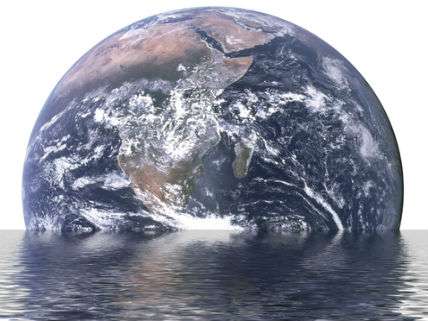Meters of Sea Level Rise and MegaBoulder-Heaving Superstorms Thanks to Global Warming
Also carbon emissions rate highest in 66 million years

A new paper, "Ice melt, sea level rise and superstorms: evidence from paleoclimate data, climate modeling, and modern observations that 2 C global warming could be dangerous," just out by climatologist James Hansen and his colleagues predicts that all climatic hell could break loose if average global temperature rises by another 1 degree Celsius. Appearing in the journal Atmospheric Chemistry and Physics, the researchers combine paleoclimate data with computer modeling to suggest that increased warming will exponentially increase ice melt from Greenland and Antarctica. The cold freshwater from the melting glaciers will trap warmer ocean water beneath which in turn will further melt the edges of the Antarctic ice sheets that are grounded below sea level. The result will be very similar to the last interglacial period, the Eemian, which stretched from 130,000 to 115,000 years ago. During the Eemian temperatures were only a few tenths of a degree warmer and sea levels were 6 to 9 meters higher than at present.
In addition, the Hansen and his colleagues suggest that colder ocean surface water will intensify atmospheric temperature gradients. This could have two effects - more intense storms and perhaps the shutting down of the Gulf Stream which would make Europe considerably less balmy. How intense might the storms become? Hansen points to boulders in the Bahamas that he argues were thrown up from the sea by superstorms to their current resting places on land. Combining superstorms with higher sea levels is not a recipe for happy coastal living.
According to the authors, the upshot is:
There is a possibility, a real danger, that we will hand young people and future generations a climate system that is practically out of their control.
We conclude that the message our climate science delivers to society, policymakers, and the public alike is this: we have a global emergency. Fossil fuel CO2 emissions should be reduced as rapidly as practical.
Interestingly, Hansen's paper follows a new paleoclimate study that looks at the Paleocene Eocene Thermal Maximum (PETM) that occurred 56 million years ago. In their Nature Geoscience article, "Anthropogenic carbon release rate unprecedented during past 66 million years," the researchers find that global carbon dioxide levels increased over a period of 4,000 years during the initial phase of the PETM at a rate of roughly 1 gigaton (1 billion tons) of per year. Eventually between 2,500 and 4,500 gigatons of carbon was released into the atmosphere and oceans. As a result, global average temperatures quickly increased by around 5 degrees Celsius. One consequence of the PETM carbon release was that lots of species went extinct in the oceans evidently due to ocean acidification caused of higher levels of dissolved carbion dioxide.
Currently, humanity is releasing about 10 gigatons of carbon annually. So far we have released about 540 gigatons: 230 gigatons into the atmosphere; 155 gigatons into the oceans; and 160 gigatons into the land. As of now average global temperature has increased by around 1 degree Celsius over the pre-industrial level. The researchers conclude…
…that, given currently available records, the present anthropogenic carbon release rate is unprecedented during the past 66 million years. We suggest that such a 'no-analogue' state represents a fundamental challenge in constraining future climate projections. Also, future ecosystem disruptions are likely to exceed the relatively limited extinctions observed at the PETM.
Since both papers essentially predict swift changes as consequence of the levels of carbon dioxide we are releasing, we should know soon if they are right. Let's hope that they are wrong.
Show Comments (118)